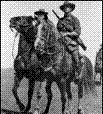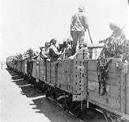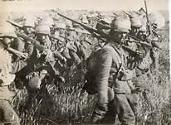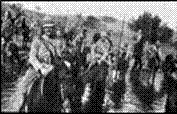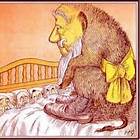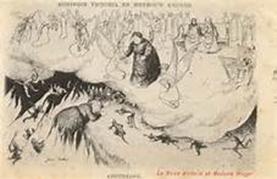
|
Unbanned Bible Publications |
|
Defending God’s Truth in Church Doctrine and Political History – Renette Vermeulen |
|
How many British soldiers fought in the Second Boer War? Perplexingly, the exact number of British soldiers that fought in the Boer War remained undisclosed. It is estimated that by early January 1900, British soldiers from England, (not counting those from the British colonies of Cape, Natal and Rhodesia,) numbered 180,000 men. The number of different military units from Britain alone numbered more than 180! Adding their Allied Imperial Forces, Britain’s number of soldiers grew to 500,000. That is at least half a million well-trained soldiers against some 64,000 - 80,000 Afrikaner farmer-hunters.
Who were the Allied Imperial Forces that fought with Britain?Among Britain’s many collaborators were a German Commando, a Dutch Corps, an Irish Brigade, American Scouts, a Russian Corps, and an Austrian Unit of trained Scouts! Britain’s commonwealth nations or ‘Clubs of Empire,’ Canada, New Zealand, and Australia also sent troops to aid the British Army in their massive offensive against the two small Republics. Chamberlain, Milner, Roberts, Kitchener, and Rhodes also used troops from the Cape colony and Indians from Natal. They even deployed Indian units from their garrisons in India and Ceylon; an estimated 18,536 men under command of the ‘so-called’ passivist,’ British sergeant major Mahatma Gandhi. Britain also paid an estimated 40,000—100,000 African mercenaries and used all the African forces they could muster from Rhodesia (now Zimbabwe,) as well as from Transvaal and the Free State. Added to this huge number of troops were the thousands of Afrikaner traitors from the Boer Republics, called ‘joiners;’ who were much despised by British and Afrikaners alike. Knowing the ways and mindsets of the Boers, these white and non-white joiners and mercenaries did the most damage to the Republics; adding immensely to the suffering of the women, children, and old men in Britain's ghastly concentration camps.
[Acknowledgement to those who published these photos]
I publish the following list of British and Allied Imperial units because it gives us an idea of their nearly incomprehensible onslaught on the vastly outnumbered Afrikaner farmers on commando, with acknowledgement to the host of http://www.icon.co.za/~dup42/bregimnt.htm. From CANADA: “The Royal Canadian Artillery: "C "B, "D" and "E" batteries, Canadian Scouts, The Royal Canadian Regiment of Infantry, The Royal Canadian Mounted Rifles, 2nd Regiment Canadian Mounted Rifles, the Royal Canadian Dragoons, and Strathcona’s Horse.” These were special units, expertly trained and the best the world could offer to crush the ‘Boers,’ or farmers! From AUSTRALIA AND NEW ZEALAND: “Australian Commonwealth Horse, and the infamous Imperial Light Horse, South Australian Mounted Rifles, 3rd South Australian (Bushmen) Contingent, 4th South Australian (Imperial Bushmen) Contingent, 5th and 6th Australian Contingent, Royal Australian Artillery, Australian Army Medical Corps, Doyle's Scouts, Intelligence Department. New South Wales Ist Australian Horse, New South Wales Artillery, New South Wales Field Hospital and Bearer Company, New South Wales Mounted Infantry, 1st New South Wales Mounted Rifles 3rd New South Wales Mounted Rifles, 1st New South Wales Bushmen, 6th Imperial Bushmen (4th New South Wales Contingent) , 3rd New South Wales Bushmen. New South Wales Lancers, Victoria 1st 2nd, 5th Victorian Mounted Rifles and Mounted Infantry, 3rd Victorian Contingent also designated as Victorian Bushmen and Australian Bushmen Army Medical Corps. From Queensland: Queensland Mounted Infantry, 3rd Queensland Bushmen, 4th Queensland Imperial Bushmen. Tasmania, Tasmanian Mounted Infantry, First or Cameron's Tasmanian Contingent , 1st Tasmanian Bushmen, 1st Tasmanian Imperial Bushmen, 2nd Tasmanian Imperial Bushmen, 4th Regiment Imperial Bushmen West Australia , 1st West Australian Mounted Infantry, 1st 2nd and 3rd West Australian Contingents, 3rd West Australian (Bushmen) Contingent, 4th West Australian Contingent (West Australian Imperial Bushmen), 5th and 6th West Australian Contingent. South New Zealand 1st, 2nd, 3rd 4th, 5th, 6th, 7th, 8th, 9th, 10th Contingents consisting of New Zealand Mounted Rifles and one Hotchkiss Gun Detachment, New Zealand Battery, New Zealand Mounted Infantry.” These were the best professional soldiers of the modern world! From INDIA: “Lumsden's Horse Ceylon, Ceylon Mounted Infantry, Commonwealth Horse West India Regiment.” Described as the most relentless and unstoppable forces in the world! From INSIDE SOUTH AFRICA: “Aberdeen Town Guard, Adelaide District Mounted Troops, Ashburner's Light Horse, Barkly West Town Guard, Bayly's Horse, Beaconsfield Town Guard. Beaufort West Town Guard, Bechuanaland Police, Bechuanaland Rifle Volunteers, Bechuanaland Protectorate Regiment, Bedford District Mounted Troops, Beddy's Scouts , Bethune's Mounted Infantry, Border Mounted Police, Border, Mounted Rifles , Border Horse, Border Scouts, Brabant's Horse, Brett's Scouts, British South African Police, Bushmanland Borderers, Bush Veldt Carbineers, Cape Colony Cyclist Corps, Cape Colony Defence Force, Cape Medical Staff Corps, Cape Garrison Artillery, Cape infantry, Cape Mounted Rifles, Cape Mounted Police, Cape Railway Capetown Highlanders, Ceres Scouts, 1st City Volunteer's (Marshall's Horse), City of Grahamstown Volunteers, Clifford's Scouts, Colonial Light Horse, Commandeering Chiefs, Bodyguard Corps of Cattle Rangers, Cradock Town Guard, Cullinan's Horse , Damant's Horse, De Aar Town Guard, De Beers Maxim Battery, Dennison's Scouts, Diamond Fields Horse, Diamond Beers Fields Artillery, District Military Police. District Mounted Troops. Dordrecht Districts Volunteer Guard, Dordrecht Wodehouse Yeomanry, Driscoll's scouts, Duke of Edinburgh's Volunteer Rifles, Durban Light Infantry, [Local Indian soldiers.] Eastern Province Horse, Eastern Transvaal Scouts, East Griqualand Mounted Rifle Volunteers, East Griqualand Field Force, Edwards's Scouts, Farmers' Guard, Fraserburg District Mounted Troops, French's Scouts, Frontier Light Horse, Frontier Mounted Rifles, Geoghegan's Scouts, Gorringe's Flying Column, Heidelberg Volunteers and Scouts, Herschel Special Police, Herschel Native Police, Imperial Light Infantry, lndwe Town Guard, Jamestown Town Guard, Jansenville District Mounted Troops, Jansenville Town Guard, Johannesburg Mounted Rifles, Johannesburg Police, Kaffrarian Rifles (commanded by Major George H. Farrar in 1900,) Kenhardt Town Guard, Keeley's Vryburg Farmer's Association, Kimberley Light Horse, Kimberley Regiment, Kimberley Town Guard, Kimberley Mounted Corps, Kitchener's Horse. Kitchener's Fighting Scouts, Klipdam Town Guard. Knysna Rangers, Koffiefontein Defence Force, Komga Mounted Infantry, Kroonstad Scouts, Laingsburg Town Guard, Loch's Horse, Lower Rhodesian Volunteer, Loyal Burgher Corps. Loxton's Horse. Lydenburg Civil Mounted Rifles. Maritzani Mounted Irregulars. Murray's Horse. Mafeking Town Guard. Menne's Scouts. Midland Mounted Rifles. Middelburg Town Guard. Molteno Town Guard. Montagu Town Guard. Montmorency's Scouts. Morley's Scouts. Mossel Bay Town Guard. Namaqualand Border Scouts, Namaqualand and District Mounted Police. Namaqualand Town Guard. National Scouts. [Indian] Natal Volunteer Field Artillery. Natal Volunteers Police and Guides Natal Bridge Guards. Natal Carbineers, Natal Mounted Police. Natal Mounted Rifles. Natal Naval Artillery. Natal Police. NataI Royal Rifles, Natal Volunteer Composite Regiment. Nesbitt's Horse. New England Mounted Rifles. Orange River Colony Police. Orange River Colony Volunteers. Orpen's Horse. Oudtsdhoorn. Volunteer Rifles. Peninsular Horse. Pietersburg Light Horse. Potchefstroom Provincial Police. Pretoria Police. Prince Albert's District Mounted Troops. Prince Alfred's Volunteer Guard. Prince Albert's District Mounted Troops. Prince of Wales' Light Horse Regiment. Piquetberg District Mounted Troops. Queenstown Rifle Volunteers. The Rand Rifles. Richmond Town Guard, Rimington's Guides, Railway Pioneer Regiment. Rhodesian Regiment. Roberts' Horse. Scott's Railway Guards. Somerset East Town Guard. South African Constabulary. South African Light Horse. South African Mounted irregular Forces. South Rhodesian Volunteers. Standerton Scouts. Steinaecker's Horse. Stellenbosch Mounted Infantry. Stellenbosch Town Guard. Steytlerville Town Guard. Struben's Scouts. Sutherland Town Guard. Tempest's Scouts. Tarkastad Mounted Troops. Tarkastad Town Guard. Tembuland Mounted Rifle Corps. Thorneycroft's Mounted Infantry. Touws River Town Guard. Transkei Mounted Rifles. Uitenhage Volunteer Rifles. Utrecht Vryheid Mounted Police. Veld Drift Town Guard. Vryburg Special Police. Walden's Scouts. Warren's Light Horse. Warren's Mounted Infantry. Warren's Scouts. Warrington Town Guard. Wellington Town Guard. Western Province Mounted Rifles. Winterberg Mounted Rifles. Willowmore Town Guard. Warwick's Horse. Younghusband's Horse, Zeerust Town Guard. Zoutleif Town Guard. Indian Staff Corp. Natal Voluntary Veterinary Corps. Natal Voluntary Medical Corps. St John Ambulance Brigade. Imperial Hospital Corps.” The British already owned the whole of South Africa — or so they thought!
BRITISH UNITS FROM ENGLAND: Most prominent among their units was Lord Roberts’ Lovat Scouts, a Scottish Highland regiment. “Naval Brigade, Royal Navy, Royal Marine, Cavalry Household Cavalry, 1st King's Dragoon Guards, 6th Carabineers, 2nd Scots Greys, Scots Guards, lst & 2nd Life Guards, lst & 2nd Royal Horse Guards (Blues), 6th lnniskilling Dragoons, 5th Royal Irish Lancers, 9th Queen's Lancers,12th Prince of Wales Royal Lancers, 16th (Queen's) Lancers, 17th (Duke of Cambridge's Own) Lancers,3rd Hussars (King's Own), 7th Hussars (Queen's Own), 13th kIussars (King's Royal Irish), 10th Hussars (Prince of Wales's Own), 13th Hussars, 14th (King's) Hussars, 18th (Victoria Mary, Princess of Wales's Own), Hussars19th (Queen Alexandra's Own Royal) Hussars 20th Hussars Imperial Yeomanry, lst, 2nd, 3rd, 4th, 5th, 6th, 7th, 8th, 9th, l0th, llth, 12th, 13th, 14th, 15th,Royal Artillery Horse Field Garrison, Elswick Battery, Honorable Artillery Company , Natal Hotchkiss Detachment, Royal Artillery Mounted Rifles Infantry, Royal Dragoons, 1st 2nd Dragoons (Royal Scots Greys)Dragoons, 6th (lnniskilling) Dragoon Guards, Ist (King's)Dragoon Guards, 2nd (Queen's Bays) Dragoon Guards, 3rd (Prince of Wales's) Dragoon Guards, 5th ( Princess Charlotte of Wales's), Dragoon Guards 6th (Carabineers,) Dragoon Guards 7th (Princess Royal's), Devonshire Regiment, lst & 2nd & 2nd Royal Inniskilling Fusiliers, 2nd Royal lrish Fusiliers, 1st Royal Irish Regiment, 1st King's Royal Rifle Corps (60th Rifles), 2nd Kings Royal Rifle Corps, 3rd King's Royal Rifle Corps, 4th King's Royal Rifle Corps, 9th King's Rifle Corps, 2nd Royal Irish Rifles Royal Dublin Fusiliers, 1st & 2nd East Kent Regiment (The Buffs), 2nd Royal West Kent Regiment (The Queen's Own)Border Regiment, 1st Coldstream Guards, 1st & 2nd Duke of Cornwall's Light Infantry, 2nd Grenadier Guards, 2nd & 3rd Scots Guards, 1st The Royal Scots, 1st & 3rd West Surrey, 2nd (The Queen's) Northumberland Fusiliers, Queen's Own Cameron Highlanders, 1st Royal Fusiliers, 2nd King's Liverpool Regiment, The Lincolnshire Regiment, 2nd The King's Own Liverpool Regiment, 1st Manchester Regiment, 1st & 2nd Duke of Cambridge's Own Middlesex Regiment, 2nd Suffolk Regiment, 1st Bedfordhire Regiment, 2nd Leicestershire Regiment, 1st Yorkshire Regiment, Ist East Yorkshire Regiment, 2nd West Yorkshire Regiment, 2nd Lancashire Fusiliers, 2nd Royal Lancaster Regiment, Royal Scots Fusiliers, 2nd Cheshire Regiment, 2nd Royal Welsh Fusiliers, South Wales Borderers, 2nd King's Own Scottish Borderers, 1st Shropshire Light infantry, 2nd (King's)Somersetshire Light Infantry, 2nd (Prince Albert's)Scottish Rifles, 1st Scottish Rifles, 2nd Cameroonians Scottish Rifles, 4th Gloustershire Regiment, 1st & 2nd Worcestershire Regiment, 1st & 2nd East Surrey Regiment, 2nd Duke of Cornwall’s Light Infantry West Riding Regiment, 1st (Duke of Wellington's)Royal Sussex, 1st Royal Warwickshire Regiment, 2nd Hampshire Regiment, 2nd Dorsetshire Regiment, 2nd Welsh Regiment, Ist Royal Welsh Fusiliers, 1st Black Watch, 2nd Royal Highlanders Oxford Light infantry Essex Regiment, 1st & 2nd Derbyshire Regiment, 1st (Sherwood Foresters)1st Loyal North Lancashire Regiment, 1st East Lancashire Regiment, 1st South Lancashire Regiment, Royal Berkshire, 2nd King's Own Yorkshire Light Infantry, 2nd King's Shropshire Light Infantry, 2nd King's Royal Rifles Wiltshire Regiment, 2nd (Duke of Edinburgh's)North Staffordshire Regiment, 2nd South Staffordshire, 1st & 4th York and Lancaster Regiment, 1st Durham Light Infantry, 1st Seaforth Highlanders, 2nd ( Rosshire Buffs, The Duke of Albany's) Gordon Highlanders, Ist & 2nd Royal Irish Rifles Connaught Rangers, 1st Argyll and Sutherland Highlanders 1st Leinster Regiment, 2nd Royal Munster Fusiliers, 1st & 2nd Norfolk Regiment, 2nd Northamptonshire Regiment, 2nd Northumberland Fusiliers, 2nd Oxfordshire Light horse infantry, 1st Highland Light infantry, 1st The Prince Consort's own Rifle Brigade, 1st Rifle Brigade, 2nd Mounted Infantry, Alderson's Mounted infantry, Amphlett's Mounted Infantry, Hannay's Mounted Infantry, Hickman's Mounted Infantry, Martyr's Mounted Infantry, Thorneycroft’s Mounted Infantry, Composite Regiment Mounted Infantry 1st, 2nd, 3rd, 4th, 5th, 6th, 7th, 8th, 9th, l0th, 1Ith, 12th, 13th, 15th, 7th, 18th (Sharpshooters), 19th (Paget's Horse), 20th (Roughriders), 21st, 22nd, 23rd, 24th, 25th, 26th Burma Mounted Infantry, Gough's Mounted Infantry, Malta Mounted Infantry Mounted Pioneers, Medical RoyaI, Army Medical Corps, Royal Army Nursing Service, Army Service Corps, Army Veterinary Department, Army Ordnance Department, Army Chaplain's Department, Divisional Scouting Corps, Military Police Corps of Military Mounted Police Imperial Bearer Company, City of London Imperial Volunteers Army Post (Office Corps.)” Why did the British not win the Boer war when they occupied the Republics?In September 1900, after the British won and lost many battles in conventional warfare, they finally advanced to Bloemfontein, the capital of the Republic of the Orange Free State and to Pretoria, the capital of the ZAR. Finally, the British were in control of the two Republics and had captured half of the Afrikaner forces. Only an estimated 30,000 to 20,000 Burghers remained in the field. The British believed that the war was over and that the Burghers in the veldt would presently surrender, but President Steyn of the Free State, under protection of General de Wet, eluded their grasp and continued to run the war from the field. WHAT REALLY HAPPENED TO THE “KRUGER MILLIONS?”The war generals of the Transvaal or ZAR unanimously decided that President Kruger should retreat to Mozambique to avoid capture by the British, which would have ended the war. From there, Queen Wilhelmina of the Netherlands, defying British occupation of the ports, sent a war ship to help the President make his escape to Europe to rally support for his country abroad. President Kruger was not a traitor, who escaped with the so-called ‘Kruger millions’ as some allege. His escape to the Netherlands was a calculated military move. It is unlikely that his war generals could have transported so much gold to Mozambique while escorting the President to safety; which would have endangered and slowed down his escape to a great degree. It is more likely that the British got hold of the so-called “Kruger millions” when they annexed Pretoria in 1900. The Sabie, Mpumalanga, South Africa website states the following, “[When Pretoria fell,] Lord Alfred Milner [said] that gold to the value of R8 million in today’s terms had been removed from the Mint and National Bank between May 29 and June 4, 1900. He confiscated gold to the value of £2.5 million and removed gold to the value of £1 294 000 from the South African Mint and National Bank.” It was Milner who circulated rumours that President Kruger had fled with the millions, which he himself could have stolen and transported to Britain; just as he had gleaned the ZAR’s gold from the Mint and the National Bank. THE COMBAT GENERALS AGREED ON GUERILLA WARFAREWith President Kruger safely on his way to Europe, after deliberation with President Steyn of the Free Sate and what was left of the ZAR government, the four Generals, Louis Botha, Jan Smuts, Christiaan de Wet, and Koos de la Rey abandoned conventional warfare methods such as trench warfare, changing to smaller commando’s that operated on ‘hit and run’ strategies. This inaugurated the “second phase” of the war. The term ‘guerilla warfare’ was not used at the time as it was virtually unheard of, and because modern terrorists or saboteurs do not resemble these men, who never harmed civilians, but focused solely on their fight against the British and their Allied troops. Under command of the two brilliant war generals, De Wet and De la Rey, the large commandos were divided into smaller ones. This meant that the commandos could operate more independently and move more rapidly. When a commando was captured or defeated, the rest remained free to carry on the fight. Devised by General Christiaan De Wet, this hit-and-run tactic proved an expert approach. In later years, his brilliant war strategies were even studied by Sinn Féin of the Irish Republican Army and other freedom fighters. Burning with the desire to retain their independence, the Boer commandos submitted almost miraculously to their commanders. So, as horse-mounted ‘guerrilla’ fighters, these hunter/farmers grew into a terrifying strike force, which moved too fast for English infantry to catch or engage. The smaller commandos were instructed to attack the British and their Allied Forces on their own terms. Picking their battles strategically, they disrupted, destroyed, and worried the operations and onslaughts of the enemy; targeting British supplies, communication, transportation, and troop carriers. Dynamite experts Lieutenant Slegtkamp and Captain Hindon became the most distinguished ‘train catchers’ of the Boers. They constantly took out the British combat trains, and caught and demolished almost every cargo they attacked. The British and Allied Forces soon became demoralized. British commanders reacted by restructuring the infantry and deploying their many respected and highly trained cavalry regiments, especially those from Australia and New Zealand, which specialized in bush warfare. However, caught between general De la Rey in Transvaal and general De Wet in the Free State, it soon became clear that the small minority of Afrikaners outweighed the many Imperial Cavalries of Britain and her allies in maneuverability and in bush warfare. The Boer commandos simply kept on mauling the thousands upon thousands of foreign forces by hitting them hardest when they least expected it. WAR-PROPAGANDA: THE BRIAN WASHING OF THE BRITISH NATION TO COMMIT GENOCIDEBritain and her Allies came to “hunt wild ‘boar!”The British believed that the Afrikaner farmers of the two small Republics would be “a tea-time snack.” They were sorely mistaken. The farmer or “Boer” commandos withstood the mighty British Empire and their Allied Forces for nearly three long years. Still, during 1899-1902, ‘elitist’ war-propaganda cartoonists constantly illustrated the so-called “uncultured, rural, conservative” (Afrikaans, ‘verkrampte’) “wild boar” of South Africa with a rifle in one hand and a Bible in the other. “Boar” was a humiliating word that replaced “Boer.”
[Acknowledgement to those who compiled the images in this study] Above: The cartoon on left depicts President Kruger as a ‘wild boar,’ nursing his baby ‘boars.’ On right: The president’s wife, ‘Tant’ [Aunt] Gezina, depicted in hell surrounded by demons before the ‘celestial’ Queen Victoria, surrounded by angels.
The aim of this dehumanizing, brainwashing-technique was twofold. These farmer communities, quickly impoverished by Queen Victoria’s cruel policy of ‘scorched earth,’ brutally incarcerated and cut off from their farms, families and African helpers, still refused to bow to the British crown. They became ‘great nuisances’ to Victoria and her war commanders. As a result, the British instructed war propaganda cartoonists to desensitize the British public, their soldiers and Allies to the suffering of Afrikaner and African fighters and civilians. Once the English and their allies became less receptive to the misery and death of whites and non-whites in the two Republics, it became easy to see these pastoral people as lesser beings. Removing a person’s humanity from the mindset of the abuser causes all forms of inhumanity to become acceptable. (Continue) |
